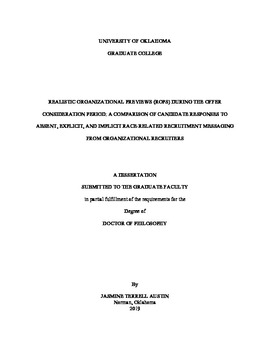| dc.description.abstract | This study addresses the critical question as to whether recruiters should provide race-related realistic organizational previews (ROP) to minority job candidates after the candidate receives a job offer to join the organization. Specifically, the researcher argues that social identity theory (SIT; Tajfel & Turner, 1985), social exchange theory (SET; Homans, 1958), and politeness theory (Brown & Levinson, 1987) represent competing theoretical explanations for what to expect from job candidates’ responses to race-related ROPs. The present study explores which of the three theories best explains the type of message that is most likely to reap the most positive outcomes for recruits and organizations. For example, a positive outcome is a minority candidate who decides to join an organization after being made aware of the potential for racially-motivated experiences and becomes less likely to exit voluntarily immediately following such experiences.
Specifically, the purpose of this study is to explore what type of race-related ROP recruitment message will enhance organizational attraction, motivation to join the organization, and intention to accept a job offer from Black job candidates, who are offered a position into a predominately White institution (PWI), and who are in the offer consideration phase of organizational socialization. The research also explores whether the job candidate may perceive the recruiter as more or less credible and polite, depending on the explicitness of the recruitment message about race and the racial identity of the recruiter.
This study discusses the passing of the conversational burden of race-related ROPs onto other organizational member who shares the same or similar racial identity as the candidate and interrogations barriers to providing race-related ROPs to a job candidate during the offer consideration phrase. This study followed a 2 (Black male recruiter vs. White male recruiter) × 3 (absent, explicit, and implicit race-related ROP message) message-processing experimental design. For this study, results demonstrated the race of the speaker did not yield any significant differences. In addition, results demonstrated that the explicit recruitment message was significantly different on several of the dependent variables as compared to the implicit and absent messages. Among these latter two, there is no difference. Though there is no statistical difference between the absent and the implicit ROP messages, the literature provides support for why the implicit race-related ROP should be adopted over the absent ROP message. Research demonstrates RJPs (and, by extension ROPs) tend to increase employee retention, therefore, the implicit ROP message strategy is superior to absent and explicit. Further, arguments were made in light of a holistic interpretation of these results for why the implicit-race related ROP message was likely most desirable to achieve recruiter image management goals (i.e., credibility and politeness) and short-term organizational goals (i.e., organizational attraction, motivation to join, and intention to accept offer). The results of this study provide support for race-related ROP messages being a strategy recruiters and organizational leaders could potentially use to recruit Black candidates into their organization effectively. These results can alleviate fears that speaking about race to recruits will undermine important and ethical efforts to achieve a more diverse workforce. This study contributes to the organizational socialization literature the idea that SIT, SET, and politeness theory are intellectual puzzle pieces needed to understand the pattern of reactions Black recruits have when processing a race-related ROP message. | en_US |

